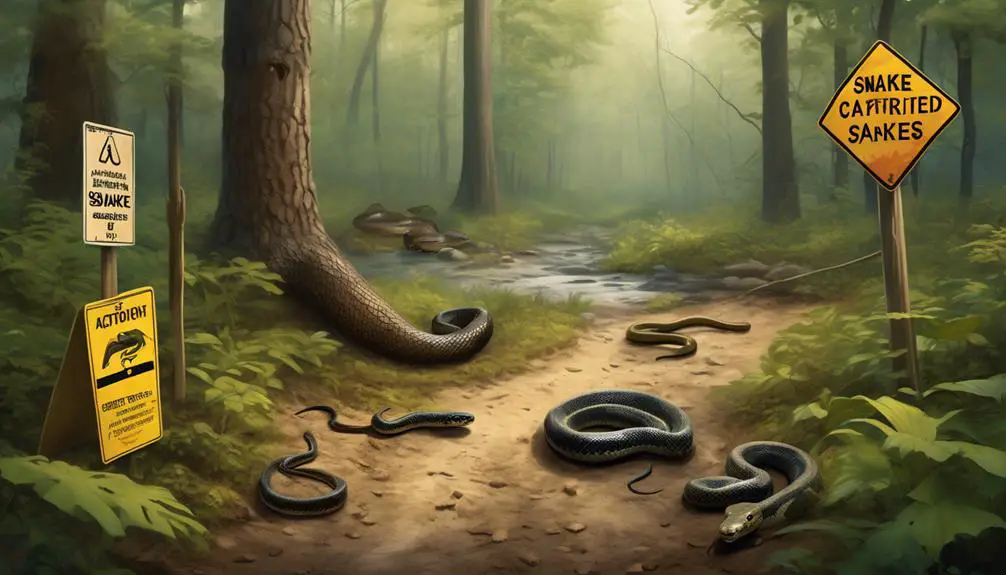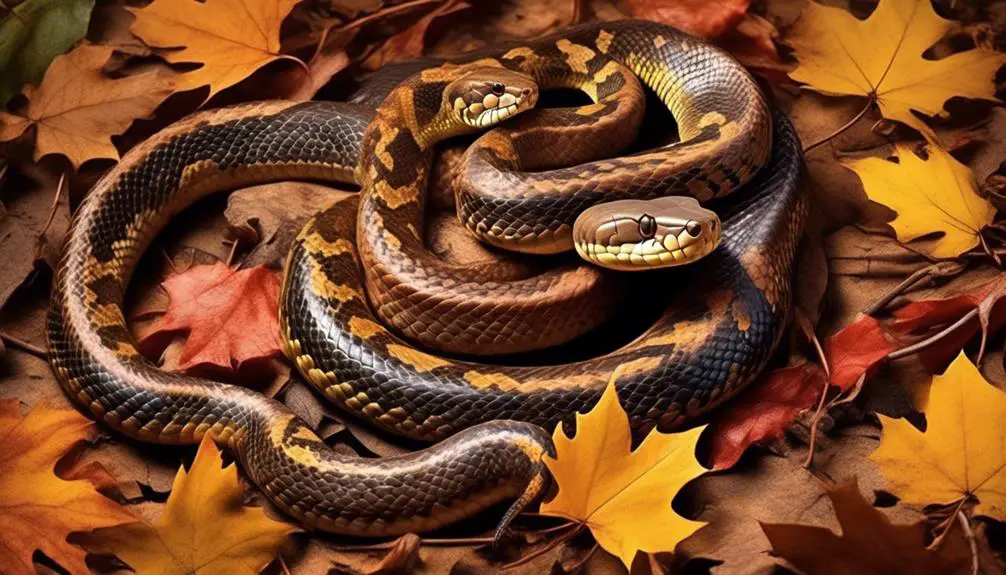Curious about the captivating creatures coiled within Michigan’s borders? Prepare to plunge into the perilous world of venomous snakes.
While Michigan is mainly known for its mild-mannered serpents, there is one slithery species that silently lurks in the shadows. This deviously dangerous denizen, the eastern massasauga, possesses a potent venom that demands your attention.
As we explore the intriguing secrets of these venomous snakes in Michigan, you’ll discover the delicate balance between fascination and fear, all while unraveling the measures necessary to ensure your safety.
Snake Species in Michigan

What snake species can be found in Michigan, and how many of them are venomous?
Michigan is home to a total of 18 snake species, with the majority, 17 to be exact, being non-venomous. These snakes vary in size and can be found in diverse locations throughout the state. It’s important to note that while the majority of snakes in Michigan are harmless to humans, there are a few non-venomous species that resemble their venomous counterparts, leading to some skepticism.
For example, the non-venomous northern watersnake bears a resemblance to the highly venomous cottonmouth, while the eastern hog-nosed snake displays defensive behaviors similar to venomous species by baring its fangs. However, when it comes to venomous snakes, there’s only one species found in Michigan – the eastern massasauga. This snake is native to North America and can be found in swamps, marshes, and grasslands. Its venom contains cytotoxin, which can destroy tissue and cause internal bleeding. Despite its venomous nature, the eastern massasauga is shy and tends to avoid human interaction, reducing the risk of snakebite.
It’s important to exercise caution when exploring habitats where the eastern massasauga may be present, wearing appropriate footwear and long pants, and watching where you step. It’s crucial to avoid handling any snakes, venomous or non-venomous, as this significantly increases the risk of being bitten.
In the United States, there are four genera of venomous snakes: rattlesnakes, cottonmouths, copperheads, and coral snakes. The eastern massasauga belongs to the rattlesnake genus. Rattlesnakes, including the eastern diamondback, are considered the most dangerous snakes in the world. Copperheads, although not found in Michigan, are common in the United States and have venom with effects similar to rattlesnakes. Cottonmouths, also known as swamp moccasins, are closely related to copperheads and are more dangerous but not as venomous as rattlesnakes. Coral snakes, found in the Americas, are rare in the United States and have venom that isn’t fatal but still dangerous.
Venomous Snake in Michigan

The eastern massasauga is the only venomous snake species found in Michigan. This snake, also known as Sistrurus catenatus catenatus, belongs to the rattlesnake genus. It is native to North America and can be found in swamps, marshes, and grasslands. The eastern massasauga is relatively small, measuring around 2 to 3 feet in length. Its venom contains cytotoxin, which destroys tissue and can cause internal bleeding. However, bites are rare, and fatal cases are even more uncommon, with only two reported fatalities. The eastern massasauga is a shy snake and tends to avoid humans, reducing the chances of getting bitten. Nevertheless, precautions should still be taken when exploring habitats where the eastern massasauga might be present. It is essential to wear adequate footwear and long pants and to watch where you step. Avoid handling any snakes, including non-venomous species, as this increases the risk of being bitten. If you encounter a snake, stay away from it and do not attempt to handle it.
| Species Name | Venomous |
|---|---|
| Eastern Massasauga | Yes |
| Northern Watersnake | No |
| Eastern Hog-nosed Snake | No |
TABLE: Venomous and Non-venomous Snake Species in Michigan
Eastern Massasauga: Habitat and Behavior

As we move on to exploring the habitat and behavior of the eastern massasauga, let’s delve into the intriguing world of this venomous snake species found in Michigan. The eastern massasauga, scientific name Sistrurus catenatus catenatus, is a small rattlesnake that inhabits wetland areas such as swamps, marshes, and grasslands. It’s primarily found in the Lower Peninsula of Michigan and is considered a state-threatened species.
The eastern massasauga is a shy and reclusive snake that prefers to avoid human contact. It’s most active during the warmer months, from April to October, and spends the winter hibernating underground. During this time, they seek out areas with suitable cover, such as decaying logs or underground burrows.
In terms of behavior, the eastern massasauga is primarily nocturnal, meaning it’s most active at night. It’s an ambush predator, patiently waiting for its prey to come within striking distance. Small rodents, frogs, and insects make up the majority of its diet.
When threatened, the eastern massasauga will typically retreat rather than confront the perceived danger. If cornered or provoked, it may resort to defensive behaviors, such as rattling its tail, a characteristic feature shared with other rattlesnake species.
Understanding the habitat and behavior of the eastern massasauga is important for both the snake’s conservation and human safety. By respecting its natural habitat and keeping a safe distance, we can coexist with this fascinating venomous snake species found in Michigan.
Snakebite Risk in Michigan

When it comes to snakebite risk in Michigan, you can breathe a little easier. The presence of only one venomous snake, the eastern massasauga, significantly lowers the risk compared to other states.
However, it’s still important to take precautions when exploring their habitats, such as wearing appropriate clothing and avoiding handling any snakes, as this increases the chances of being bitten.
Low Snakebite Risk
With only one venomous snake species present, Michigan offers a relatively low risk of snakebite. The eastern massasauga, native to North America, is the only venomous snake in Michigan. It can be found in swamps, marshes, and grasslands. Although its venom contains cytotoxin, which destroys tissue and can cause internal bleeding, the eastern massasauga is shy and avoids humans, reducing the chances of getting bitten.
Bites are rare, and fatal cases are even more uncommon, with only two reported fatalities. To further minimize the risk, it is important to wear adequate footwear and long pants when exploring habitats where the eastern massasauga might be present. Additionally, avoiding handling any snakes, including non-venomous species, is crucial to reduce the risk of being bitten.
| Venomous Snake Species in Michigan |
|---|
| Eastern Massasauga |
Precautions and Safety
To minimize the risk of snakebite in Michigan, it’s crucial to take precautions and practice safety measures while exploring habitats where the eastern massasauga, the only venomous snake in the state, may be present.
First and foremost, it’s important to wear adequate footwear and long pants to protect yourself from potential snake encounters.
When walking in areas where the eastern massasauga resides, watch where you step and avoid tall grass, dense vegetation, and rocky areas where snakes may be hiding.
It’s essential to remember that snakes, even non-venomous ones, should never be handled as this increases the risk of being bitten.
In the event that you encounter a snake, maintain a safe distance and avoid any attempts to handle it.
Importance of Avoiding Handling
Avoiding handling snakes is crucial in Michigan to minimize the risk of snakebite. This is especially important since the state is home to the only venomous snake, the eastern massasauga. While the chances of encountering this shy snake are low, it’s still important to take precautions when exploring its habitat. Wearing appropriate footwear and long pants is essential, as is watching where you step.
It’s crucial to remember that handling any snake, including non-venomous species, increases the risk of being bitten. If you come across a snake, it’s best to stay away and avoid attempting to handle it. By following these guidelines, you can significantly reduce the risk of snakebite and ensure your safety while enjoying Michigan’s natural beauty.
Precautions and Safety Measures

To ensure your safety when exploring snake habitats in Michigan, it’s important to take certain precautions.
Firstly, always wear protective clothing such as long pants and adequate footwear to minimize the risk of snake bites.
Secondly, it’s crucial to avoid handling any snakes, both venomous and non-venomous, as this significantly increases the chances of being bitten.
Lastly, be aware of snake habitats, particularly swampy areas, and exercise caution in these environments by staying away from snakes and refraining from attempting to handle them.
Protective Clothing and Footwear
Wearing appropriate protective clothing and footwear is crucial when exploring snake habitats in Michigan to minimize the risk of snake bites. By taking these precautions, you can greatly reduce the chances of being bitten by a venomous snake. Here are some essential items to consider:
| Protective Clothing | Protective Footwear |
|---|---|
| Long pants | Sturdy boots |
| Thick, long-sleeved shirt | High-top shoes |
| Gaiters or snake chaps | Closed-toe shoes |
| Gloves | Thick socks |
| Hat |
Long pants and a thick, long-sleeved shirt provide a barrier between your skin and any potential snake encounters. Gaiters or snake chaps can be worn over your pants for added protection. Sturdy boots or high-top shoes with closed-toe designs are essential to prevent snake fangs from penetrating your footwear. Additionally, wearing thick socks and gloves can provide extra protection. Don’t forget to wear a hat to shield your head and neck from any potential snake strikes. Remember, it is important to be cautious and wear appropriate clothing and footwear when exploring snake habitats in Michigan.
Avoiding Snake Handling
Taking precautions to avoid handling snakes is essential for your safety when exploring snake habitats in Michigan. Remember, even non-venomous snakes can bite if they feel threatened. To minimize the risk of snake encounters, it’s important to wear appropriate clothing and footwear. Opt for long pants and sturdy, closed-toe shoes or boots.
When walking in snake-prone areas, watch where you step and avoid tall grasses, brush piles, and rocky areas where snakes may hide. Keep a safe distance if you encounter a snake, as they can strike when provoked. Don’t attempt to handle or touch any snakes, as this can increase the chances of being bitten.
Awareness of Snake Habitats
When exploring snake habitats in Michigan, it is crucial to have a thorough understanding of the precautions and safety measures necessary to be aware of snake habitats. The table below provides a summary of the key safety measures to follow:
| Precautions and Safety Measures |
|---|
| Wear adequate footwear and long pants |
| Watch where you step |
| Avoid handling any snakes, including non-venomous species |
| Stay away from snakes and do not attempt to handle them |
Other Venomous Snakes in the United States

In the United States, there are four genera of venomous snakes. These include rattlesnakes, cottonmouths, copperheads, and coral snakes.
Rattlesnakes, such as the eastern diamondback, are considered the most dangerous snakes in the world. They are shy but possess venom that can cause severe tissue damage and even death if left untreated.
Copperheads, although not found in Michigan, are common in the United States. Their venom has similar effects to rattlesnakes, primarily targeting the nervous system.
Cottonmouths, also known as swamp moccasins, are closely related to copperheads. While not as venomous as rattlesnakes, their bites can still be dangerous due to the bacteria present in their mouths.
Coral snakes, found in the Americas, are rare in the United States. Their venom contains neurotoxins that can cause paralysis and respiratory failure.
It is important to exercise caution when encountering any venomous snake and avoid handling them.
Conclusion: Safety in Michigan’s Snake Population

To ensure your safety when encountering snakes in Michigan, it is important to exercise caution and avoid handling any snake, whether venomous or non-venomous. Although Michigan is home to only one venomous snake species, the eastern massasauga, it is still essential to take precautions when exploring habitats where it might be present. Wearing adequate footwear and long pants and watching where you step can help minimize the risk of snakebite. Remember that snakes are generally shy and will try to avoid humans, so it is best to stay away from them and not attempt to handle them.
To summarize the safety measures, here is a table that provides a comparison of venomous and non-venomous snakes in Michigan:
| Venomous Snakes in Michigan | Non-Venomous Snakes in Michigan |
|---|---|
| Eastern Massasauga | Northern Watersnake |
| Eastern Hog-nosed Snake | |
| Garter Snake | |
| Eastern Milk Snake |

Erzsebet Frey (Eli Frey) is an ecologist and online entrepreneur with a Master of Science in Ecology from the University of Belgrade. Originally from Serbia, she has lived in Sri Lanka since 2017. Eli has worked internationally in countries like Oman, Brazil, Germany, and Sri Lanka. In 2018, she expanded into SEO and blogging, completing courses from UC Davis and Edinburgh. Eli has founded multiple websites focused on biology, ecology, environmental science, sustainable and simple living, and outdoor activities. She enjoys creating nature and simple living videos on YouTube and participates in speleology, diving, and hiking.

